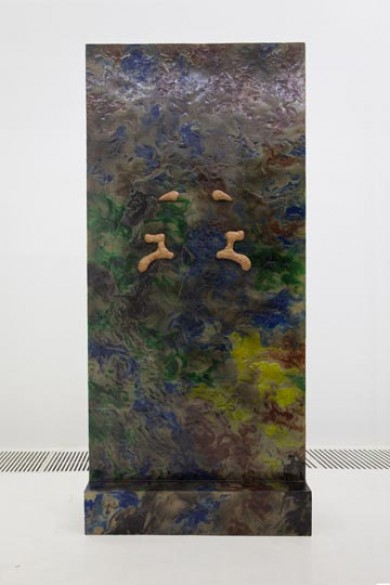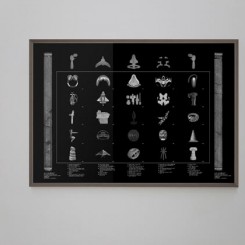“Survivors’ Hunting“, Guan Xiao solo exhibtion
Magician Space (798 East Road, 798 Art Zone, No.2 Jiuxianqiao Road, Chaoyang District, Beijing 100015). Jan. 12 – Mar. 24, 2013.
Guan Xiao’s latest work touches on interesting topics — time, archeology and what our material culture says about our spiritual culture — but it fails to unearth anything truly substantial.
Guan Xiao’s recent exhibition at Magician Space stood out for its sheer strangeness. It gave a sense of the juxtaposition of past and future, primitive and classical, crude and high-tech — all wrapped up in an awkward formal aesthetic.
Take her work “Cloud Atlas” for instance; when w think of monoliths or their Chinese variety, steles, we expect them to be placed in wide open spaces à la “Planet of the Apes,” or the monumental stone steles of Xi’an. One does not expect to find them crammed cheek by jowl into a gallery that must be no larger than 5 x 5 m. What’s more paradoxical about these weighty forms is their texture— a kind of pseudo-marbling, as if the effluents of some cloth-dying factory have spilt into a river, leaving swirls of brown, blue, green and sickly yellow. (Although this was surely unintentional, the smell of the resin somehow managed to highlight this effect). These works are then finished with varnish and adorned with other objects made out of resin which was made to look almost like a varnished terra cotta. Simply moulded, these forms when placed all together form the eyes, nose, ears, and mouth of a primitive-looking bronze mask of the work “Museum Approach” which is placed further away on an opposite wall. But as isolated objects affixed to the steles, these noses or mouths look vaguely phallic or scatological in appearance. I think it is no accident that the work is called “Cloud Atlas,” named after a film featuring a number of storylines set in the past, present, and future, and which deal with both primitive and futuristic societies.

Guan Xiao, “Cloud Atlas (detail)”, 5 parts sculpture, 270 x 120 x 50 cm. 2013 关小,”云图(局部)”, 5部分雕塑, 270 x 120 x 50 cm, 2013
Guan Xiao seems, in addition, to construct a dialogue between some older, more primitive culture and a more classical one, be it Greek or Chinese, thus hinting at archeology but at the same time juxtaposing classical and primitive forms. This neolithic feel is juxtaposed with the 90s-era pseudo-futurism of the resin, which moves further into an intergalactic territory with the series “Core Sample” — sculpture-like objects which can only be described as tripods which look vaguely insect-like, with a profusion of awkward legs. These cold metal objects stand out in stark contrast with the warmth of the steles, but Guan has given them hand-holds made of the same brown and fluorescent resin, creating a visual link between the two works. Though the title points towards geological exploration in order to study our past, the colors of the “samples” indicate that these strange instruments have been used to drill beneath the crust of some foreign planet to reveal radioactive compositions beneath.

Guan Xiao, “The Core Sample,” 6 pieces metal sculpture, dimensions variable, 2013
关小,”核样”, 6件金属雕塑, 尺寸可变, 2013

Guan Xiao, “Cognitive Shape,” 3-screens digital HD video, 8min 12sec, 2012
关小, “认知的形状”, 3屏高清数码录像, 2013
In the other room is another video with a new-age “instructive” flavor to it. A woman (Guan Xiao) dressed in a salmon pink suit speaks in a very calm manner against an audio background of light drumming, while a series of strange images flash across the screen: a woman simultaneously swinging two yo-yos, a floating balloon and a CGI image of an primitive carved eagle, which turns into a stone tablet of sorts. Then there is what seems to be a kind of “time-line of form” which begins with the tablet and then branches off in different directions (almost like an evolutionary diagram). Each branch bears different objects which slowly morph into other objects — bowls, coins, carved masks, wrenches and golf balls. The thematic pivot of these works is the idea of hunting and collecting. It is in fact an interesting principle — the idea that the concept of a “collector” could take us back to the days of our ancestors collecting carved objects made out of rock or clay. But somehow the message could be a bit clearer. The mish-mash of internet imagery and new-agey aesthetic in this exhibition was intriguing, but failed to really drive home any clearly discernible message. Overall, this sums up my issue with this show as a whole. The accumulated elements pointed in interesting directions, but failed to help us arrive at any concrete destination.

